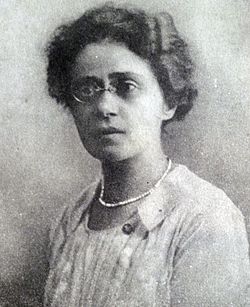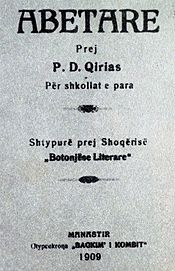Parashqevi Qiriazi facts for kids
Quick facts for kids
Parashqevi Qiriazi
(Paraskevi D. Kyrias) |
|
|---|---|

Parashqevi Qiriazi
|
|
| Born | June 2, 1880 |
| Died | December 17, 1970 (aged 90) |
| Relatives | sister of Gjerasim Qiriazi (1858–1894), Gjergj Qiriazi (1868–1912), and Sevasti Qiriazi (1871–1949) |
| Signature | |
Parashqevi Qiriazi, also known as Paraskevi D. Kyrias (2 June 1880 – 17 December 1970) was an Albanian teacher of the Kyrias family who dedicated her life to the Albanian alphabet and to the instruction of written Albanian language. She was a woman participant at the Congress of Manastir, which decided the form of the Albanian alphabet, and the founder of the Yll' i Mengjesit, a women's association. Parashqevi was also a participant in the Paris Peace Conference, 1919 as a member of the Albanian-American community. She was the sister of Sevasti Qiriazi, who was the director of the Mësonjëtorja, the first Albanian School for girls to open in 1891.
Biography
Parashqevi was born in Monastir (now Bitola, in the Manastir Vilayet, Ottoman Empire (present-day North Macedonia). When she was only 11 she started to help her brother Gjerasim Qiriazi and sister Sevasti Qiriazi to teach written Albanian to girls in the first school for girls in Albania, the Girls' School (Albanian: Shkolla e Vashave), which opened on 15 October 1891.
She later studied at Robert College in Istanbul. Upon graduation she went to Korçë to work as an elementary teacher along with her sister, Sevasti at the Mësonjëtorja, the first Albanian school which had opened in 1887.
In 1908, she was a participant in the Congress of Monastir and the only woman to be there.
In 1909, she published an abecedarium for elementary schools. Although the Congress of Monastir had decided about the new alphabet, two versions of the alphabet were still present in her abecedary, which shows how fragile the consensus of the Congress still was. However, along with the abecedarium, she published some very well known verses on the defense of the new Albanian alphabet:
| Albanian Tosc | English |
|---|---|
|
Armiqëtë o shqipëtarë, |
The enemies o Albanians, |
She is also known for having organized teaching for children and night schools in other southern Albania villages and have also helped with the organization of local libraries.
She contributed to the foundation of the Yll' i Mëngjesit association (Albanian: Morning Star) in 1909 and later, when she had emigrated to the US, she continued to publish the periodical with the same name from 1917 to 1920. The magazine was published every fortnight and consisted in Albania related articles which included politics, society, history, philology, literature, and folklore.
In 1914 she left Albania for Romania along with her sister as a consequence of the Greek occupation of the city.
She later went to the United States and became a member of the Albanian-American community, on behalf of which she participated in the Conference of Peace of Paris in 1919 to represent the rights of the Albanians.
Parashqevi returned to Albania in 1921, and since after, she followed with interest the political developments in the new Albanian state, without taking out of sight the national aspirations. She became one of the founders and directors of the Female Institution named "Kyrias" (as per family name) in Tiranë and Kamëz, in cooperation with her sister Sevasti, and brother in law Kristo Dako.
In October 1928, with the initiative of the Ministry of Interior, the organization "Gruaja Shqiptare" ("The Albanian woman") was founded in Tirana, with the directives to create branches nationwide and in the diaspora. It was created under the patronage of Queen Mother, and King Zog's sister princess Sanije. The organization aimed at promoting education, hygiene, and charitable activities, and raising Albanian woman at a higher cultural level. As a well-educated woman, Parashqevi succeeded in gaining a leadership position in it. Between 1929 and 1931, the organization would publish its periodical Shqiptarja ("The Albanian [f]"), where Parashqevi and her sister Sevasti would contribute a lot. The journal was distinguished for problematic articles which sought to refute conservative thinking which was contrary to women's movement and its demands.
Parashqevi stood as a firm antifascist throughout all WWII starting from the Italian invasion of 1939. Because of her anti-fascist views, she and her sister were imprisoned and deported in the Anhalteleger Dedinje camp near Belgrade by the pro-Nazi units led by Xhaferr Deva.
She survived and returned to Tirana after the war. Unfortunately, another persecution would follow her and her sister's family. Because of some pro-Zog standings of Kristo Dako, his name would be annihilated by the communist regime, following with the Kyrias families would be interned away from Tirana. Her two nephews (Sevasti's sons) would be imprisoned, and eventually one died in prison.
With some immense efforts by the Albanian scholar Skënder Luarasi, and a later intervention by Vito Kapo, the Kyrias sisters would be partially rehabilitated. Parashqevi died in Tirana on December 17, 1970.
Legacy
Parashqevi Qiriazi and her sister Sevasti are considered the mothers of Albanian education. The Albanian-American Women Organization (AAWO) in New York City is named "Qiriazi Sisters" as well. 7 March is the official Teachers' Day in Albania, in remembrance of the Qiriazi family school opening of 1891.
The Albanian movie Mësonjtorja ("The school") of 1979 produced by Kinostudio Shqipëria e Re is dedicated to her and her brother Gjerasim, even though their names appear different (Dafina and Stefan).
Several schools in Albania and Kosovo bear the names of Qiriazi family.
Read also
- Albanian alphabet
- Congress of Monastir
- Kyrias Family
- Fatbardha Gega
See also
 In Spanish: Parashqevi Qiriazi para niños
In Spanish: Parashqevi Qiriazi para niños


